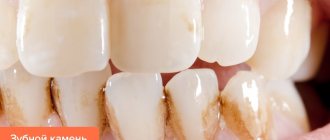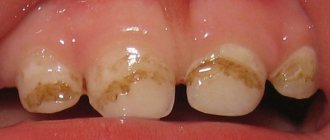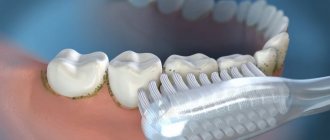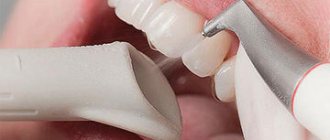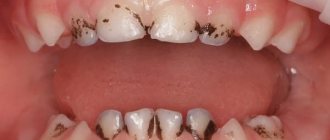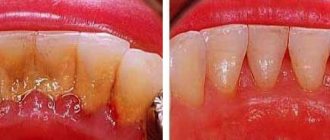What are dental deposits?
Such formations on the teeth appear even in those who regularly and conscientiously brush their teeth and take care of their oral cavity. Deposits on teeth are formed under the influence of various factors. They affect not only the crown of the tooth, but also the surface of the gums. Dental deposits often cause the development of diseases of the gums and teeth. They are irritating to the gums and tooth enamel, as they contain a huge amount of bacteria and their metabolic products. Partially, soft plaque is removed when brushing your teeth. But this is only provided that the oral cavity is cleaned correctly and regularly. If personal hygiene rules are not followed, plaque remains on the teeth, between them and gradually leads to the formation of hard deposits.
Mechanism of formation of tartar
The causes of tartar are as follows: after eating food, particles remain in the mouth. They act as a favorable environment for the proliferation of pathogenic bacteria. They give greater preference to easily digestible carbohydrates: particles of sweet food, baked goods. Experts have found that even one day of lack of hygiene doubles the amount of bacterial plaque in the mouth.
Nutrients are used by microorganisms for more than just reproduction. They also secrete special enzymes - enzymes, which allow them to firmly attach to the surface of the tooth enamel. Lack of hygiene leads to the fact that individual pinpoint colonies quickly merge into one “plaque”, forming an impressive mass of plaque. Before it begins to mineralize, it can be easily brushed off with a toothbrush.
With the gradual mineralization of soft deposits, stone formation occurs. Calcification occurs as follows: calcium salts, which are part of saliva, settle on the soft plaque. Mineralization is accompanied by the process of layering of new and new colonies of bacteria, which leads to an increase in the volume of solid deposits.
The mechanism of tartar formation is accompanied by processes such as the release of toxic substances and inflammatory mediators by plaque. This becomes the cause of inflammatory processes in soft tissues. Symptoms of this complication are:
- bleeding of the gums - due to mechanical stress, and in severe cases, spontaneous;
- redness, cyanosis, swelling of the gums;
- soreness, itching;
- the appearance of pus in periodontal pockets;
- mobility of individual teeth.
Inflammation contributes to an even greater increase in the number of bacteria. In the place where the gums adhere to the surface of the tooth there is a periodontal groove, into which liquid with salts and proteins is produced from the gums. This leads to the growth of bacterial colonies. With inflammation, this fluid becomes larger, resulting in an environment for reproduction that is even more favorable for microorganisms. Calcification occurs even faster.
Types of dental plaque
- Dental plaque is a soft deposit that gradually accumulates on teeth, fillings, and dentures. It is formed from food residues and waste products of bacteria. This deposit is firmly fixed on the teeth and can only be removed by physical methods;
- soft clusters resemble a thick mass of white-yellow color. Also formed by bacteria, their waste products, saliva and food debris;
- leftover food.
Mineralized deposits. These include tartar. It can be supragingival and subgingival. It has a dense structure and dark color. There are several factors that contribute to the formation of dental plaque:
- content in the diet of too soft food;
- disruption of metabolic processes in the body;
- preference to chew on only one side;
- malocclusion.
Tartar is formed, as a rule, in places where there is bad impact during brushing and self-cleaning does not occur.
After the removal procedure
After removing hard deposits, the doctor must polish the teeth - plaque accumulates more slowly on a smooth surface. Also, to consolidate the effect and strengthen the enamel, a product containing fluoride can be applied - a solution, gel in drops or fluoride varnish.
It is important to find out the reasons for the formation of tartar in order to take the necessary preventive measures. If one of the factors is a disease or metabolic disorder, consultation with a specialized specialist and correction of the condition is recommended.
Common prevention methods include:
- professional teeth cleaning twice a year - it can be difficult to remove all the plaque that forms on your own, especially if we are talking about an incorrect bite or other structural features of the dental system. It is necessary to visit a hygienist once every 6 months, and for those who wear orthodontic appliances - once every 4-5 months;
- maintaining oral hygiene at home - brushing your teeth twice a day, flossing;
- compliance with certain measures outside the home - use a mouthwash after eating, do not forget about flossing;
- limiting the consumption of foods that contribute to the appearance of a large amount of plaque (tea, coffee, sweet, sticky foods, baked goods);
- choosing a brush with the optimal degree of bristle stiffness (it is better to consult a doctor);
- choosing a paste containing pyrophosphate (in consultation with your doctor) - this component suppresses the formation of tartar;
- preference for solid products as a method of mechanical cleaning of teeth.
Causes of deposits on teeth
When dental plaque forms, the reasons for this phenomenon can be identified as follows:
- Using toothpastes that do not meet all requirements.
- Brushing your teeth with a soft brush, which does not cope 100% with its task.
- Low content of vegetables, fruits and other solid foods in the diet.
- The diet is dominated by thermally processed food, which easily gets clogged between the teeth.
The most important reason for the appearance of deposits on teeth is poor oral hygiene or incorrect teeth cleaning technique. It is important to know that the teeth brushing procedure should last from 3 to 5 minutes, only then can you effectively get rid of all deposits.
Hygiene and prevention in dentistry
Dental plaque
In the practice of a dentist, about 90% of patients with poor oral hygiene are encountered every day. Unsatisfactory or improper brushing of teeth leads to the formation of dental plaque, which subsequently leads to gum disease and tooth loss. First, a soft plaque appears, which irritates the gums and tooth enamel. One week is enough for the soft plaque to turn into hard deposits or tartar. And so there are two groups of dental deposits:
- Non-mineralized: Dental plaque. This is a soft deposit that gradually accumulates on teeth, fillings, and dentures. It is formed from food debris, waste products of bacteria and saliva. Soft clusters resemble a thick mass of white-yellow color. This deposit is firmly fixed on the teeth and can only be removed by physical methods.
- Mineralized deposits. These include tartar. It can be supragingival and subgingival. It has a dense structure and dark color.
There are several factors that contribute to the formation of dental plaque:
- Containing too soft food in the diet.
- Disturbance of metabolic processes in the body.
- Preference to chew on one side only.
- Malocclusion.
- Presence of periodontitis.
- Poor oral hygiene.
- Features of the structure of teeth.
Tartar is formed, as a rule, in places where there is bad impact during brushing and self-cleaning does not occur.
When dental plaque forms, the reasons for this phenomenon can be identified as follows:
- Using toothpastes that do not meet all requirements.
- Brushing your teeth with a soft brush, which does not cope 100% with its task.
- Low content of vegetables, fruits and other solid foods in the diet.
- The diet is dominated by thermally processed food, which easily gets clogged between the teeth.
- The structure of the enamel may not be entirely smooth, so it easily retains deposits.
- Uneven distribution of load on teeth.
- Smoking causes darkening of the enamel.
- Inflammatory diseases of the oral cavity.
The most important reason for the appearance of deposits on teeth is poor oral hygiene or improper brushing techniques. It is important to know that the teeth cleaning procedure should last from 3 to 5 minutes, only then can you effectively get rid of all deposits using all the necessary hygiene products: toothpastes, brushes, dental floss, interdental brushes, tongue brush, rinses, irrigators.
Stages of formation of dental plaque
Dental plaque goes through several stages in its formation:
- At the first stage, minerals accumulate, this takes up to 2 months, and then crystal growth begins.
- At the second stage, the crystals are improved. The process begins after 60 days and continues up to 1.5-2 years.
- Stage three is characterized by crystal saturation.
It can be noted that the first stage is soft plaque, and stages 2 and 3 are hard dental deposits.
Diagnosis of dental deposits
Detecting plaque on teeth is a fairly simple matter. Even if you run your tongue over their surface, you can feel it if there is a coating. The surface of the teeth does not seem so smooth. You can see it in the mirror; such deposits are best visible on the lower jaw from the inside. Smokers can easily see the plaque, as it most often has a brownish color. At the pharmacy you can buy special pastes or tablets that color the plaque a different color, but the most effective way is to visit a dentist, who will determine how much your oral hygiene can be assessed.
How to get rid of dental plaque
If you can deal with soft plaque on your teeth through your own efforts by practicing careful oral hygiene, then only a specialist can remove tartar. In dental clinics there are special tools for removing dental plaque, as well as various methods. After examination, the doctor, depending on the type of deposits, chooses a method of removal.
Mechanical removal of dental plaque.
Removal of dental plaque in this way is carried out manually or using special equipment. You can combine different cleaning methods to achieve the perfect result. At the end of the procedure, the dentist uses brushes and special pastes to polish the enamel and the patient leaves the office with a snow-white smile. Mechanical cleaning involves the use of the following methods:
- The manual method is carried out using special curettes. It is often combined with other methods. Personal manual cleaning is used only when the patient is contraindicated to use the devices. This happens in the presence of epilepsy, diabetes and some other pathologies.
- Removing dental plaque using a modern “Air Flow” device.
This is an effective way to remove dental plaque. The method allows you to remove even large stones without damaging tooth enamel. The powder jet method involves spraying a mixture of water and powder, effectively removing plaque and polishing the enamel. This method often complements the removal of dental plaque with ultrasound, eliminating tartar residues. - Removal using laser. This method is also possible, but due to its high cost it is rarely chosen by patients.
Chemical removal of tartar.
If mechanical methods of removing deposits do not give the desired result or the case is particularly complex, then you will have to resort to the help of chemistry. If there is greater mobility of teeth or deposits are located in large clusters, then a gel is applied, which contains: alkalis, acids, iodine. It is capable of destroying plaque. The composition is applied for just one minute, and then removed, and the mouth is rinsed with water. If this method of combating dental plaque is used, the dentist must carefully protect the gums from the effects of the gel. Based on this, it can be argued that the root zone of the tooth remains poorly cleaned, so the method is considered insufficiently effective.
Rules to be followed when removing sediments
Despite the fact that modern dentistry has great potential, the removal of dental plaque must be carried out under strict adherence to the following rules:
- All devices and instruments must be treated with antiseptic solutions to avoid infection of the patient's tissues.
- When starting to remove tartar, it is necessary to treat the oral cavity with an antiseptic solution.
- The doctor should work in special protective glasses to avoid damaging the eyes with pieces of tartar.
Removing deposits using ultrasound
should be used with extreme caution in patients with heart disease. It is PROHIBITED to use this method:
- If you have a pacemaker.
- If there are implants in the oral cavity.
- Bronchial asthma and bronchitis.
- The presence of hepatitis and tuberculosis.
- Diabetes.
- If there is increased sensitivity, which can provoke a gag reflex.
- During pregnancy and while breastfeeding, it is better to refrain from such procedures.
- Such methods are also contraindicated for children and adolescents
When visiting a dentist, you must inform him about the presence of chronic pathologies or existing acute diseases. Whatever method of teeth cleaning is used, the procedure should end with polishing the enamel. existing diseases in acute form.
How to prevent the formation of dental plaque
The following recommendations must be followed:
- Regularly, morning and evening, thoroughly brush your teeth; the procedure should not last less than 3 minutes. Movements should be sweeping and circular.
- Use special pastes that remove plaque well.
- Reduce the amount of sweets and starchy foods in your diet; this environment is favorable for the accelerated proliferation of bacteria.
- Do not overuse strong tea or coffee, they can stain tooth enamel.
- Include more fresh vegetables and fruits in your menu so that the oral cavity self-cleanses from plaque.
- Use dental floss to remove food debris between teeth.
- Rinse your mouth after eating with plain water.
Modern hygiene products not only give freshness to your breath, but also help restore whiteness to your teeth, get rid of plaque and prevent the formation of tartar.
The most important thing is to use them regularly, do not forget about personal hygiene, then no plaque is scary, it simply will not have a chance to appear. If you have questions about proper oral care, then you should visit a dentist, he will explain everything and help you choose teeth cleaning products, and if necessary, he will find ways to remove dental plaque. Be sure to visit the dentist 2 times a year for preventive examinations, and also carry out professional oral hygiene. The material was prepared by dentist-therapist of the highest category Dmitrieva N.L.
Diagnosis of dental deposits
Detecting plaque on teeth is a fairly simple matter. Even if you run your tongue over their surface, you can feel it if there is a coating. The surface of the teeth does not seem so smooth. You can see it in the mirror; such deposits are best visible on the lower jaw from the inside.
Smokers can see the plaque without any problems, since it most often has a brownish color. At the pharmacy you can buy special pastes or tablets that color the plaque a different color, but the most effective way is to visit a dentist, who will determine how much your oral hygiene can be assessed.
Prevention of tartar formation
The only reliable and effective means of prevention is control over the quality and regularity of dental and gum care.
Be sure to brush your teeth at least 2 times a day (morning and evening), ending each procedure with the use of an irrigator. This will help remove soft plaque from areas that traditional oral hygiene products cannot reach.
In addition, it is important to monitor your overall health, promptly seek bite correction and minimize the consumption of fast carbohydrates such as baked goods, sweets, etc.
More detailed information is presented in the catalog of oral irrigators.
Mechanical removal of deposits
Removal of dental plaque in this way is carried out manually or using special equipment. You can combine different cleaning methods to achieve the perfect result. At the end of the procedure, the dentist uses brushes and special pastes to polish the enamel, and the patient leaves the office with a snow-white smile.
- The manual method is carried out using special curettes. It is often combined with other methods. Personal manual cleaning is used only when the patient is contraindicated to use the devices. This happens in the presence of epilepsy, diabetes and some other pathologies.
- Ultrasound removal of dental plaque. This is an effective method of removal using a modern device. The method allows you to remove even large stones without damaging tooth enamel.
Symptoms
You can see tartar even during a visual inspection, especially if you look at the inside of the lower jaw. Pathology is indicated by a characteristic yellow or brownish coating along the side surfaces and neck of the tooth root. With significant amounts of stone, painful sensations in the gums may be present, which forces the patient to seek medical help.
Other symptoms of tartar include:
- bad breath caused by compounds of organic elements and sulfur;
- redness and swelling of the gum tissue, its bleeding during intensive morning cleaning;
- pain and injury to inflamed gums during eating;
- increased sensitivity of teeth to cold and hot foods, which is caused by exposure of the tooth root and its reaction to foods;
- unattractive appearance of teeth due to a noticeable yellow tint.
Stages of development and types
The chemical composition of dental plaque includes a set of organic and organic substances. These are calcium and magnesium phosphates, calcium carbonate, and compounds of some other metals. The organic component includes epithelium, leukocytes, microorganisms, a mixture of proteins and polysaccharides.
Depending on the location there are:
- supragingival calculus is located along the tooth line above the gums and is formed mainly on the lower front teeth;
- subgingival calculus is localized in the periodontal pocket on the surface of the tooth root;
- stone bridge - a formation that captures several teeth through the spaces between them and has a common edge line.
The formation of tartar occurs in several stages:
- accumulation of organic and mineral substances occurs, from which a crystal begins to grow;
- the volume of deposits increases as new layers of plaque appear;
- the so-called saturation of the crystal occurs, associated with its solidification.
On the surface of the tooth, the stone can be located:
- on the bone tissue of the root and neck of the tooth;
- on uneven surfaces: filling, place of partial destruction of enamel, etc.;
- on the surface of the enamel;
- in areas of penetration of bacterial plaque into the tooth structure.
Complications
Failure to remove tartar in a timely manner can cause the development of:
- gingivitis, associated with swelling and bleeding of the gums;
- periodontitis, in which the inflammatory process affects not only the gums, but also the bone tissue near the affected tooth;
- cardiovascular diseases associated with the penetration of pathogenic microorganisms through the teeth into the circulatory system.
Chemical removal of tartar
If mechanical methods of removing deposits do not give the desired result or the case is particularly complex, then you will have to resort to the help of chemistry. If there is greater mobility of teeth or deposits are located in large clusters, then a gel is applied, which contains: alkalis, acids, iodine. It is capable of destroying plaque. The composition is applied for just one minute, and then removed, and the mouth is rinsed with water. If this method of combating dental plaque is used, the dentist must carefully protect the gums from the effects of the gel. Based on this, it can be argued that the root zone of the tooth remains poorly cleaned, so the method is considered insufficiently effective.
What is the danger of tartar
Why is it so important to see a dentist? There are several unpleasant and dangerous consequences of tartar:
- halitosis or bad breath - as a result of the constant proliferation of pathogens;
- inflammation of the gums - gingivitis, periodontitis, as well as inflammation of the mucous membranes of the oral cavity (tongue, cheeks, lips, etc.) - microbes release toxins, inflammatory mediators, which causes the inflammatory process;
- spread of inflammation - in the absence of treatment, inflammation covers the tissues that hold the teeth in the jaw, the dentogingival attachment is disrupted, which leads to periodontitis and periodontal disease: loosening, the appearance of periodontal pockets with purulent contents, bone tissue atrophy, exposure of the necks of the teeth, and their loss;
- caries - soft and hard deposits contain microorganisms that provoke the appearance of caries. This occurs due to the release of hydrochloric acid, which destroys the enamel. The resulting defect is populated by pathogenic flora and a carious cavity is formed;
- general deterioration of condition and well-being - toxins released by bacteria are absorbed into the blood, which complicates the course of chronic diseases and can affect the functions of organs and systems.
That is why, regardless of the cause of tartar, it is important to seek professional dental help - removal.
Who is contraindicated for dental cleaning?
Manual removal of tartar or soft plaque has practically no contraindications, which cannot be said about the use of devices. Such removal of deposits is contraindicated in the following conditions and pathologies:
- for heart diseases;
- if there are implants in the oral cavity;
- bronchial asthma and bronchitis;
- presence of hepatitis and tuberculosis;
- diabetes;
- if there is increased sensitivity, which can provoke a gag reflex;
- during pregnancy and while breastfeeding, it is better to refrain from such procedures;
- Such methods are also contraindicated for children and adolescents.
When visiting a dentist, you must inform him about the presence of chronic pathologies or existing acute diseases.
Features and types of dental plaque
In dental practice, dental plaque is any plaque, regardless of the nature of its appearance. It can appear both on the surface of the enamel and in the most unusual places, for example, between the tooth and the gum. Such deposits are divided into two main groups: soft and hard.
Soft deposits appear from food debris, dying cells, as well as from various microorganisms that have entered the oral cavity. These deposits are very soft in their consistency, which is why they received the appropriate name. They are easily destroyed and removed by regular brushing and rinsing your mouth. However, if you do not get rid of them in time, such deposits will harden over time.
Hard plaque is formed mainly due to the accumulation of various inorganic substances, bacteria, and also during the mineralization of food debris. Deposits of this type are characterized by a dense and hard composition, which cannot be removed with a regular brush or thread. This plaque is called tartar and can only be treated in a dental clinic. Independent treatment methods are ineffective.
Hard plaque can also be classified according to where it appears:
- Above the gums. Such deposits are easy to notice visually; most often they appear as yellow or brown spots on the teeth.
- Under the gums. It is impossible to notice such a plaque with the naked eye. Externally, the tooth looks absolutely healthy; the disease can be diagnosed only after a thorough examination.
The presence of deposits may be indicated by the condition of the gums. Tartar causes swelling and bleeding, causing the gums to take on a characteristic blue tint. In some cases, even purulent foci are observed, but such cases are extremely rare.
Stages of development of dental plaque
If a hard layer of deposits has formed, this indicates insufficient oral hygiene. If formations appear under the gum, this may be due to problems connecting bone tissue and gums. Subgingival formations are the most complex type of disease. Removing them qualitatively is far from an easy task; it will take a lot of effort and time.
Getting rid of stones on teeth using improvised means
If there is tartar, how to get rid of it at home? We invite you to study some folk recipes:
- Use toothpastes with abrasive particles and a hard brush for cleaning, then you can get rid of soft plaque and even remove small stones.
- Prepare a decoction of 40 grams of walnut bark or shell and a glass of boiling water. You need to dip your brush in it and brush your teeth, adding a little toothpaste.
Removing dental plaque using folk remedies is a long process; you won’t be able to get rid of tartar in one use, so you will have to be patient and use the product regularly. If folk remedies do not help cope with plaque on the teeth, then you will have to visit a specialist who will quickly and safely return you have a beautiful smile and healthy teeth.
Removing dental plaque: methods used in modern dentistry
To remove dental plaque in dentistry, physical and hardware methods can be used. In the first option, special tools are used to remove deposits - stone and plaque - hooks, scalers, finishers. However, the physical method of removing dental plaque is used quite rarely, only when there is a need to remove tartar from deep gum pockets, from which it is difficult to remove it in other ways.
Why has removing dental plaque with hand instruments become unpopular among modern dentists? It's simple, this method is less advanced than modern technologies for removing plaque and tartar. Manual removal of dental plaque is a labor-intensive process, the effectiveness of which will largely depend on the level of knowledge and qualifications of the dentist. Moreover, when manually removing dental deposits, irregularities remain on the teeth, in which plaque will accumulate even more actively.
Due to the considered disadvantages, manual removal of dental plaque is rarely carried out; hardware methods for removing plaque and tartar are more often used - Air Flow technology and ultrasonic cleaning.
Air Flow technology for removing dental plaque
This technology is ideal for removing soft and pigmented deposits from tooth surfaces.
The procedure for removing plaque is quick and without discomfort for the patient and, in addition to removing plaque, it helps to lighten the tooth enamel a little - by approximately 2-3 shades, to its natural shade. When removing dental plaque using Air Flow technology, teeth are cleaned by applying a powerful air-water flow to their surface, which contains abrasive particles (soda).
Air Flow dental plaque removal is an effective and gentle method of combating plaque, but with all its advantages, it does not help get rid of tartar. To carry out high-quality removal of hard dental deposits, teeth are cleaned with ultrasound. We will talk about this technology in detail in a separate section of our article.
How to prevent the formation of dental plaque
If everything is so bad with personal hygiene that tartar has formed, how to get rid of it at home or with the help of a dentist is clear, but maybe it’s easier to prevent its formation? To do this, you don’t have to do anything complicated, you just need to follow the following recommendations:
- Regularly, morning and evening, thoroughly brush your teeth; the procedure should not last less than 3 minutes. Movements should be sweeping and circular.
- Use special pastes that remove plaque well.
- Reduce the amount of sweets and starchy foods in your diet; this environment is favorable for the accelerated proliferation of bacteria.
- Do not overuse strong tea or coffee, they can stain tooth enamel.
- Include fresh vegetables and fruits in your menu so that the oral cavity self-cleanses from plaque.
- Use dental floss to remove food debris between teeth.
- Rinse your mouth after eating.
- Even if nothing hurts, you need to make it a rule to visit the dentist every six months.
Modern hygiene products not only give freshness to your breath, but also help restore whiteness to your teeth, get rid of plaque and prevent the formation of tartar. The most important thing is to use them regularly, do not forget about personal hygiene, then no plaque is scary, it simply will not have a chance to appear. If you have questions about proper oral care, then you should visit a dentist, he will explain everything and help you choose teeth cleaning products, and if necessary, he will find ways to remove dental plaque.
Methods for treating tartar
Treating tartar on your own at home is not possible. Tartar removal is performed using practical and painless methods in the dentist’s office:
- Ultrasonic cleaning. This is the treatment of tartar with a scaler. The equipment generates low-frequency ultrasonic vibrations that destroy dental plaque. After this, the dentition is washed with a stream of water, and the enamel is ground and polished.
- Air Flow whitening system. In this case, cleaning is performed with an abrasive compound supplied under pressure through a special nozzle. The composition includes air, water and sodium carbonate. The equipment does an excellent job of cleaning the interdental space and effectively removes stubborn plaque.
- Laser cleaning. This is a non-contact technique that does not cause discomfort or pain. Tartar cleaning is performed with a directed laser beam, the remaining particles are washed out of the oral cavity with a water-air jet.

